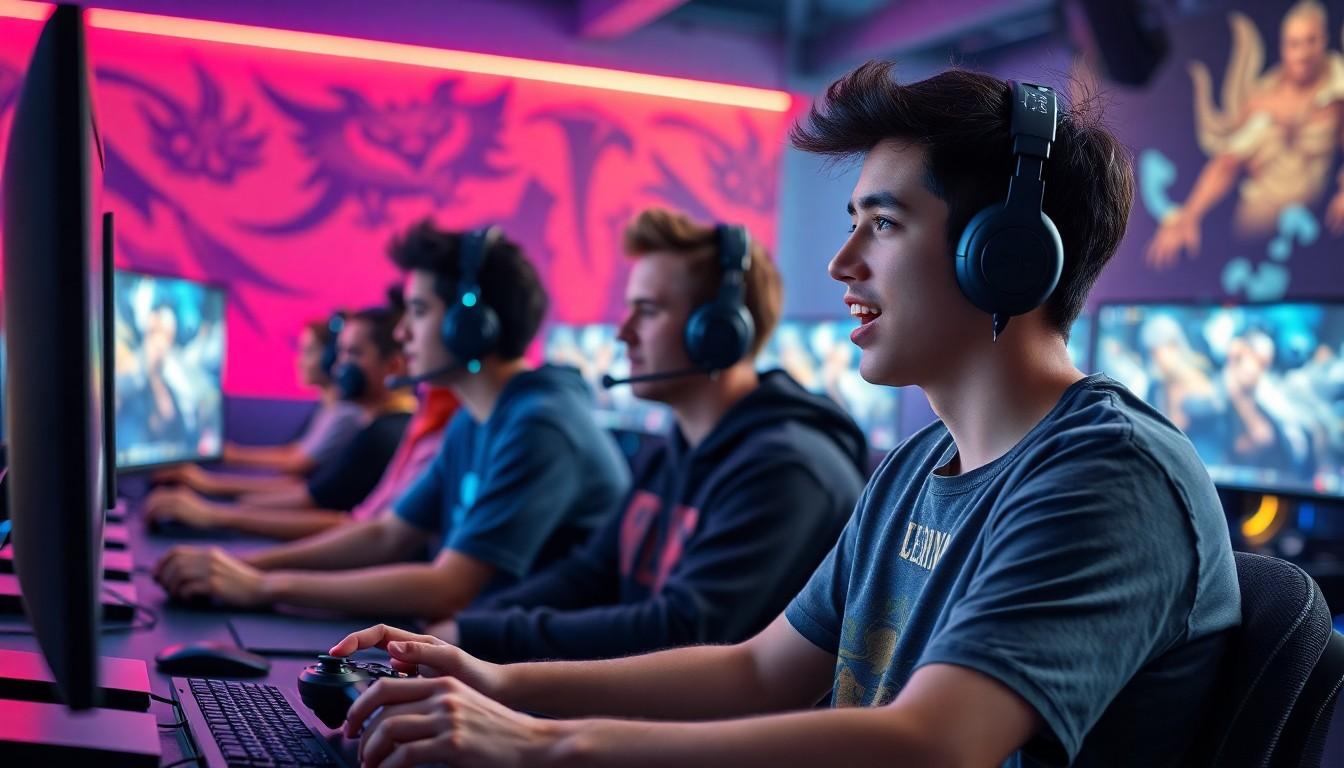Physical Address
304 North Cardinal St.
Dorchester Center, MA 02124

In the world of gaming, few genres have taken the spotlight quite like MOBA (Multiplayer Online Battle Arena) games. Picture this: a virtual battlefield where strategy meets skill and teamwork is the secret sauce to victory. Whether it’s outsmarting opponents or executing that perfect combo, MOBA games turn casual players into adrenaline-fueled warriors, all from the comfort of their couches.
MOBA gaming refers to a genre where players control individual characters in teams to defeat opponents. These games require strategic thinking, quick reflexes, and effective communication for victory.
MOBA stands for Multiplayer Online Battle Arena. Players engage in competitive gameplay, controlling a singular character, often called a champion or hero. Maps typically include three lanes, a jungle area, and base structures that teams aim to destroy. Unique character abilities and roles contribute to comprehensive strategies involving offense and defense. Popular mechanics involve leveling up characters, acquiring in-game items, and cooperating with teammates to secure objectives.
League of Legends ranks among the most famous MOBA games, featuring millions of active players worldwide. Dota 2 follows closely, known for its deep gameplay mechanics and large esports tournaments. Heroes of the Storm offers a blend of universes from Blizzard’s franchises, appealing to a diverse audience. Smite provides a unique third-person perspective, enhancing player immersion. Each of these games attracts a dedicated community, contributing to the genre’s growth and popularity.

MOBA gaming has undergone significant changes since its inception, reflecting shifts in technology, player preferences, and competitive dynamics.
Origins trace back to the early 2000s, when mods for existing real-time strategy games gained popularity. “Defense of the Ancients” (DotA) for Warcraft III marked a turning point. Players enjoyed controlling individual heroes and engaging in team battles. This format attracted a dedicated following, leading to the development of stand-alone titles.
Multiplayer capabilities and online connectivity propelled growth. As internet access expanded, more players could participate. These factors contributed to the rise of MOBA games and established a foundation for future innovations.
Several key milestones shaped the MOBA genre. In 2009, Riot Games launched “League of Legends,” introducing player rankings and frequent updates. The game’s success drove interest in competitive play and esports.
“Dota 2” followed in 2013, featuring a robust tournament scene and significant prize pools. Major events like The International showcased top-tier talent and attracted millions of viewers worldwide.
2015 saw “Heroes of the Storm,” which incorporated characters from various Blizzard franchises. This unique blend appealed to a broader audience and emphasized teamwork. Each development solidified MOBA gaming’s place in the gaming industry.
Successful players use various strategies to excel in MOBA games. Key approaches involve team composition and effective map control techniques.
Effective team composition balances roles within the game. Each team needs a tank, damage dealer, and support to cover weaknesses. Damage dealers inflict significant harm to opponents, while tanks absorb damage and control fights. Supports provide healing and utility, enabling the team to capitalize on engagements. A five-player setup allows for diverse synergies, enhancing team performance. For instance, pairing high-damage assassins with crowd control champions can create opportunities for quick eliminations. Prioritizing synergy maximizes effectiveness and promotes teamwork.
Map control plays a crucial role in MOBA strategies. Dominating specific areas allows teams to secure objectives and gain vision. Vision wards illuminate key locations, helping teams avoid ambushes. Securing jungle camps grants experience and gold advantages. Timely rotations between lanes can catch opponents off-guard. Additionally, grouping near objectives like Dragon or Baron enhances the likelihood of securing them. Effective communication signals intent, ensuring the team coordinates efforts for map dominance. Mastering these techniques improves chances of victory significantly.
MOBA gaming significantly shapes the esports landscape. Competitive structures thrive within this genre, attracting large audiences and substantial sponsorships.
Professional leagues and tournaments define the competitive scene. These leagues, such as the League of Legends Championship Series (LCS) and the Dota Pro Circuit (DPC), reflect the dedication of players and teams. Participants showcase skill, teamwork, and strategy through intense matches. Broadcasted games attract millions of spectators, emphasizing the entertainment value. Rankings and seasonal tournaments drive competitive spirit, motivating players to excel. The establishment of franchises increases stability and revenue opportunities, ensuring growth within the esports community.
Significant tournaments highlight the prowess of MOBA games. The International, held annually for Dota 2, boasts the largest prize pool in esports, attracting top players globally. League of Legends World Championship captivates audiences with its spectacular production quality and thrilling gameplay. Events like the Mid-Season Invitational and the ESL One further amplify interest in the genre. These tournaments unify communities and create memorable moments, reinforcing MOBA’s influential role in the esports industry. Spectators anticipate each event, forming connections with players and teams as they navigate the competitive landscape.
MOBA gaming continues to evolve, with new opportunities and challenges on the horizon. Key trends indicate the genre’s dynamic nature, pushing boundaries in gameplay and engagement.
Game developers invest heavily in cross-platform play, allowing players on different devices to compete seamlessly. Competitive integrity improves as developers implement better anti-cheat systems, ensuring fairness in matches. Additionally, mobile adaptations of popular titles like League of Legends: Wild Rift cater to a broader audience, tapping into the mobile gaming market. Community-driven content, from fan-made skins to in-game events, strengthens player engagement and loyalty. Esports integration grows, with professional teams expanding into various media formats, including live-streaming platforms and social media channels.
Saturation poses a significant threat, with numerous new titles entering the market, making it harder for individual games to retain player interest. Balancing gameplay remains challenging as developers introduce new characters and mechanics while avoiding power creep. Community toxicity can deter new players, creating barriers to entry and engagement. With rapid advances in technology, keeping up with player expectations becomes essential; failure to do so risks losing a competitive edge. Furthermore, economic fluctuations in esports sponsorships can impact the viability of professional leagues and tournaments, potentially limiting future growth in the genre.
MOBA gaming continues to thrive as a dynamic and engaging genre that captivates players worldwide. Its blend of strategy teamwork and skill keeps both casual and competitive gamers invested. As the genre evolves with new technologies and community-driven content the future looks promising.
Challenges may arise but the resilience of the community and the excitement of esports ensure that MOBA games will remain a significant part of the gaming landscape. With ongoing innovations and adaptations players can expect thrilling experiences that push the boundaries of competitive gaming. The journey of MOBA gaming is far from over and its impact on the gaming industry will undoubtedly grow.